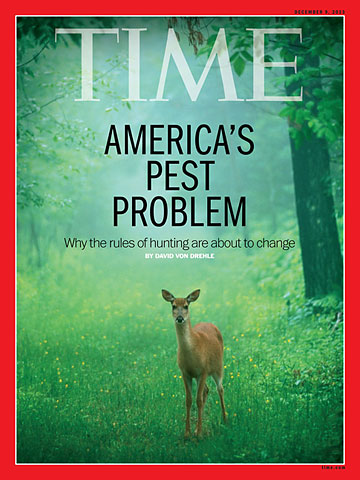
(2 of 7)
Whether you're a Walmart employee in Florida wondering what to do with the alligator at your door, a New Yorker with a hawk nesting on your high-rise or an Ohio golfer scattering a flock of Canada geese, you now live, work and play in closer proximity to untamed fauna than any other generation of Americans in more than a century. Even as the human population climbs toward 320 million in the U.S., plenty of other creatures are flourishing too.
This was no sure thing. A child born around 1930 stood a pretty good chance of outliving the last white-tailed deer in the U.S. Abundant when the first European settlers arrived, the brown-eyed beauties had been hunted nearly to extinction. A sense of loss, even doom, hung over the U.S. publication of Felix Salten's novel Bambi, translated from German in 1928 by a left-wing intellectual named Whittaker Chambers. But Walt Disney, among others, imagined a different ending. As Chambers morphed into a conservative and the child of 1930 approached her teen years, Disney's studio made Bambi into the animated masterpiece credited with helping turn a nation in love with Buffalo Bill into the conservation-minded America of today.
The psychic shift symbolized by Bambi reshaped the population of American fauna so dramatically that one Saturday morning early this year, a child born around 1930--Dorothy Pantely, 83, of the Pittsburgh suburbs--witnessed not the extinction of the deer but rather the sudden arrival of two whitetails in the hallway outside her bedroom. Thinking quickly, Pantely activated her emergency medical alert. When police showed up, they found the picture window smashed, the carpet damaged, the adult deer escaped--and a frightened yearling left behind. "It was just the worst thing ever," Pantely said afterward.
Too many deer, wild pigs, raccoons and beavers can be almost as bad for the animals as too few. This is why communities across the country find themselves forced to grapple with a conundrum. The same environmental sensitivity that brought Bambi back from the brink now makes it painfully controversial to do what experts say must be done: a bunch of these critters need to be killed.
FROM PESTS TO PROTECTED
Nowhere has this stirred more emotion than in New Jersey, America's most densely populated--by humans, that is--state. Weeks before the start of the annual bear hunt, protesters were preparing for another year of heartbreak. From a low of about 50 bears around 1970, the number of black bears in New Jersey jumped seventyfold, to an estimated 3,500, by 2009. Complaints about bruins raiding trash cans, mauling pets--even breaking into houses--led state officials to institute the bear hunt in 2010. Since then, hunters have harvested (that's the preferred term in wildlife-management circles) nearly 1,350 black bears, bringing the species' population in New Jersey down by about 20%.
